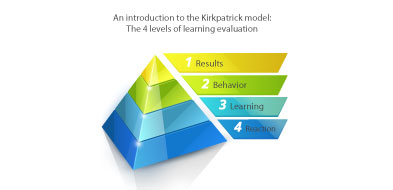The key purpose of running learning programs is to meet goals such as higher sales, positive customer feedback, better productivity, and efficiency. However, if the impact of these learning programs is not measured, an organization cannot identify whether their training efforts are yielding any positive result or not.
Listed below are seven effective ways to help you measure the impact of your learning programs and maximize it:
1. Align your L&D metrics with business metrics
To understand this, we can take the example of a company that plans to launch a CRM platform for their sales and marketing team that should replace the existing tools in five months.
• In this case, the entire sales and marketing team has to go through the training. After mapping the training to the relevant profiles to acquire three levels of tool proficiency, the L&D team plans the training modules.
• The next step involves using the assessment scores to assess the gain in proficiency. However, what is missing is the business metrics. For instance, the new CRM platform with all tools in one place will save almost an hour daily for the sales & marketing team. This could be used to increase their target by 10%.
• Lastly, aligning the L&D metrics with business metrics will directly impact the business and is a great way to determine the impact of the CRM platform on the business.
Thus, just running learning programs is not enough. It is essential to make sure that the learning is actually contributing to the growth and development of both your employees and your organization by measuring its impact.
2. Conduct employee engagement surveys
• Take note of the feedback from your employees taking part in learning programs.
• Observe the trends in the engagement charts of your learning programs as it will give you useful insights about your programs.
• Also pay attention to retention rates since it will help you improve your L&D initiatives to a great extent.

3. Analyze performance and business statistics
You should analyze both performance and business statistics against KPIs and KRAs.
• Performance metrics will help L&D managers understand the effectiveness of your learning programs if they really deliver what they are intended to deliver.
• Similarly, improved business metrics will point to high learning impact and vice versa.
• Analyzing business statistics is vital to find out if your business has gained anything from the learning program. Moreover, to analyze both performance and business metrics, you need to identify the evaluation model that will help you measure both.
4. Compare application and retention levels before and after training
Today, employees are more likely to stick for a long period at a company wherein their knowledge and skills are regularly enhanced and developed. Such an organization also attracts more applicants when you hire for open positions. So it is essential that you do a thorough comparison of employee application and levels before and after training.
• The assessment will help you measure learning impact efficiently as it will tell you if there is any improvement in application and retention levels pre and post employee training.
• If you find that the training was unsuccessful in making any significant impact, then you will have to make some changes to it and then compare the employee application and retention levels again.

5. Evaluate employee productivity
Evaluate the productivity of your employees as it will clearly show you the impact of your learning programs.
• If employees complete an assigned work in less time with better quality, this demonstrates an excellent learning impact. However, if there is little to no impact on productivity, it means that your learning program has failed to enhance employees’ knowledge and skills and you will have to bring some changes to it.
• Define and measure tasks that relate to the main job functions or use broader measures. Examples include how many sales calls were made, how fast customers were served, how many orders were delivered, etc.
• Conduct a client survey to evaluate your employees’ performance. It is a great way to get valuable feedback and then track it back to the employees when a certain order or service didn’t occur per the plan. Exceptional employee performance can also be identified and rewarded by this approach.
6. Select the Right Evaluation Model
Identify the right evaluation model to clarify what you have to measure, how you have to measure, and how you will identify and understand evaluation results. For instance, you could use the Kirkpatrick model to measure training effectiveness and its impact on your organization.
Level 1: Reaction
Start with finding out the reaction of learners. See if your employees found the training to be engaging, relevant, and simple to apply. You can do this by conducting online surveys and polls.
Level 2: Learning
Do a validation to determine if the training objectives and cognition levels have been achieved. You can do this by evaluating the summative assessment scores.
Level 3: Behavior
Do a validation if there is a change in learner behavior that can be directly attributed to the training. You can do this by polling the employees and their supervisor after 30/60/90 days and then validating the required gain. The gain is measured by combining L&D and business metrics.
Level 4: Impact
In the last stage, do a validation if the training created the required value for the business and was able to impact the business KPIs. You can do this by tracking the parameters collected in the business metrics and attaching the Kirkpatrick model graphic

7. Conduct practice and skill checks
Your learning program is effective if it positively affects employees’ performance. So it is important that your learners can do the tasks and apply them in their work rather than just holding knowledge.
• Allow employees to practice the real tasks that they will do on the job. This can then be used to conduct their skill checks and development.
• Give criteria for the practice skill/partner checker to help them assess the way of measuring learning impact. This can be done by checking if the learner did the task to the desired ability and providing a way for supervisors to give feedback.
Final word
On a final note, it can be said that measuring the impact of learning is an essential step for organizations to objectively evaluate their learning impact.
What strategies do you use to measure the impact of learning? Schedule a demo to learn how Infonative can help you effectively measure the impact of your learning programs. Learn more on https://infonative.net/. For any queries, feel free to reach out to us at yg@infonative.net.
Check our articles for resources you and your team may need.
Read next: 5 Ways To Adapt Your L&D Team For The Hybrid Workplace




